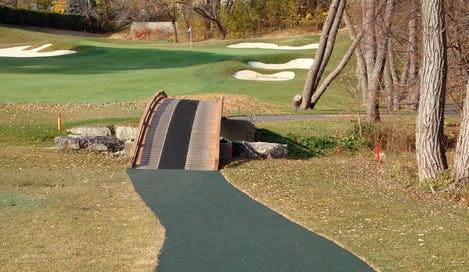A golf course without cart paths is a rarity. Having them come into play is not. Knowing your “cart path rights” is a necessity.
First things first. A player is entitled to relief from the cart path in any of these situations: 1) the ball is in contact with the cart path, 2) a player's normal stance is in contact with the cart path, or 3) the player's swing is interfered with by the cart path (e.g. the ball is resting close enough to the edge of the path that the club head will contact the path during the swing).
Second, relief from the cart path is an "entitlement" not a "requirement." If for some reason a player prefers not to seek relief from the cart path, they may play the ball as it lays.
Third, here is how we go about determining our relief: 1) leave the ball (temporarily) where you found it. 1) Use a tee to identify the nearest point (no closer to the hole) where the ball could be placed where the cart path no longer interferes with your swing and stance. 2) Holding the ball at knee height, the player must drop the ball at any point within a club's length of this point (no closer to the hole). 3) As long as the dropped ball does not roll more than two club lengths, does not roll closer to the hole, nor rolls back onto the cart path, the ball is now in play.
(note: Obstructions and relief are addressed in rule 16 of the USGA's Rules of Golf. These are expanded upon in the USGA's Decision on The Rules of Golf.)
Bottom Line: Remember the above entitlements and you'll be on the right path to handle the cart path.
Each Thursday we’ll bring you a helpful insight.
Swing to the Target,
Ed
YouTube Videos: https://www.youtube.com/channel/UCAEGsro5bKTSibrvf4uQpfg
Have golf buddies? Share this article.






Ed, You are a legend!!! Its fun to swing the club instead of hitting balls. Dead strait ropes and birdie putts all day:)